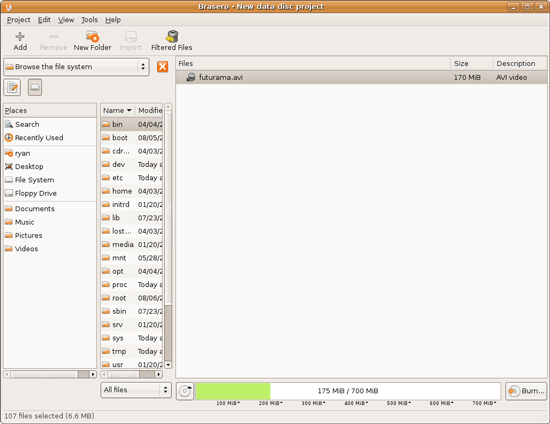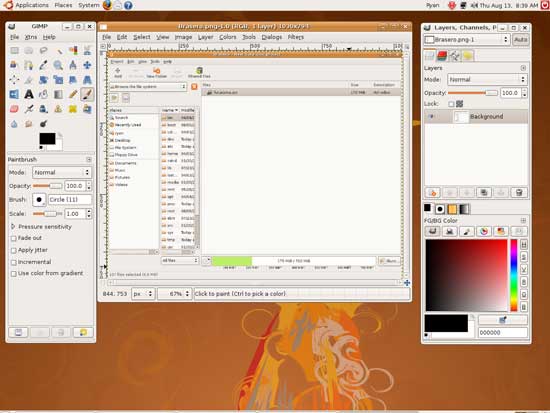Revisiting Linux Part 1: A Look at Ubuntu 8.04
by Ryan Smith on August 26, 2009 12:00 AM EST- Posted in
- Linux
Applications: CD Burning/Image Editing
Windows Default: Drag & Drop
What I use: Nero
Ubuntu Default: Drag & Drop / Brasero
One of my minor annoyances with Mac OS X and Windows is that their default disc burning abilities are insubstantial. Both offer drag-and-drop file burning, audio CD burning through their respective audio suites, and in Mac OS X’s case it offers ISO burning too, but that’s it. As a long-time Nero user, I would rather have the finer level of control a disc authoring suit such as Nero or Toast offer when it comes to building and burning discs.
As it turns out, this is something that Ubuntu gets right. Not only does it include drag-and-drop burning abilities like the other OSes, but it includes a disc authoring suit: Brasero. In a nutshell, Brasero is a clone of Nero Burning ROM, much like Rhythmbox is a clone of iTunes. It sports similar UI elements as Nero, including the handy disc capacity meter towards the bottom of the window. As such, for anyone used to Nero it’s an easy transition to make.
Where Nero users will feel left out is that it’s only a clone of Nero Burning ROM, and little else. It can burn audio CDs, data discs, ISOs, and copy whole discs, but that’s it. It doesn’t have any audio/video mastering abilities like Nero does. In fact there’s nothing on the default Ubuntu install like this – Windows Movie Maker and iMovie have no direct counterpart on Ubuntu. This makes Ubuntu more capable than Windows or Mac OS X for data CDs, but underpowered for most kinds of media disc creation. Depending on how you use Ubuntu, this may or may not be an issue.
Meanwhile for users accustomed to drag-and-drop burning, you’ll find the drag-and-drop CD/DVD Creator satisfactory. As CD/DVD Creator doesn’t support packet writing, you’re limited to traditional building & burning via the GUI. CD/DVD Creator doesn’t support writing multisession discs either, so it’s entirely a write-once operation. Whether this is a problem or not depends on if you use packet writing – a quick check around here didn’t turn up anyone that uses it, so I’m not sure there are all that many people that are going to miss it.
For power users there are other options. The Ubuntu repositories contain other disc authoring suites, and a cut-down version of Nero is available too. We haven’t had a chance to check out either of these, but it looks like neither option provides a solid audio/video authoring package. Anyone needing such abilities may need to look elsewhere. For daily use however, it has everything I need.
Final Verdict: Meets My Needs
Windows Default: Paint
What I use: Adobe Photoshop CS3
Ubuntu Default: GIMP
In doing research for this section of our look at Linux, one thing became abundantly clear: Image editors on Linux have the potential to be a holy war. For Windows and Mac OS X the gold standard for image editing programs is Adobe Photoshop, but as Adobe does not offer it for Linux it’s up to the Linux community to fend for itself. In doing so they came up with the GNU Image Manipulation Program (GIMP) which strives to match Photoshop’s abilities on *nix for free. What results is an interesting situation.
In spite of the fact that I can barely make sense of Photoshop, it’s clear that GIMP is not just a Photoshop clone, for better or for worse. For someone looking for what would amount to a Linux version of Photoshop, they’re clearly going to be disappointed, as GIMP is not Photoshop or even Photoshop-lite. It’s an advanced image editor that is in a class of its own.
As far as default programs are concerned, GIMP is clearly miles and miles ahead of Windows’ Paint, and Mac OS X’s complete lack of a freestyle image editor (iPhoto being the next-closest thing). Even if it’s not up to Photoshop’s level of abilities, it’s a very capable image editor that comes with Ubuntu, rather than needing to be a separate program download on Windows or Mac OS X. This leaves me in a somewhat odd position.
Paint is anything but powerful, but it’s also simple. GIMP and Photoshop have at least one thing in common: they’re both capable of being complex beasts. As such I’m not convinced that it’s a good thing that GIMP is the default image editor on Ubuntu. For a beginner, it may be too powerful for its own good. For those reasons while it’s the most powerful default image editor when compared to Windows or Mac OS X, I’m not sure it’s the “best” if we’re to consider what fits user needs.
At any rate, when it comes to my own uses, I’ve previously mentioned that I’m not particularly competent than Photoshop. For image preparation for our articles it does the job nicely, while it’s clearly overkill for the task. For what little I do with Photoshop, GIMP works quite well, giving it the distinction of being the only default image editor that does what I need. For these reasons while it’s not a perfect replacement for Photoshop overall, it more than meets my needs for day-to-day use.
Final Verdict: Meets My Needs












195 Comments
View All Comments
fepple - Friday, August 28, 2009 - link
That is exactly how the usability tests are performed. Developer asks Mom "can you change the background" then records what they dofepple - Friday, August 28, 2009 - link
So i tried to find some links about this relating to gnome, but only got some pretty old ones. There are other methods they are using as well, like the 100 paper cuts idea. honestly have a look around and you'll see how much of a focus it is, particularly with ubuntuap90033 - Friday, August 28, 2009 - link
Face it, Linux is still back in Windows 2000 days. Try getting SLI working, 1080P working right, games working. IT IS Way to much trouble and damn near impossible for regular users. In Windows or Mac its next to no work and very little issue. Wake up guys, Linux has Potential but thats it. BECAUSE those who advocate it spend so much energy defending what is "easy" to them when they ought to use that energy making it ACTUALLY easy and USER USER USER USER (DO YOU UNDERSTAND THIS WORD?) FRIENDLY... NOT PROGRAMMER FRIENDLY...newend - Wednesday, September 2, 2009 - link
All of the things you mention are probably not that easy for grandma to do either. People thrive on saying it's so hard to do things in Linux, but I think it's generally not intuitive to use most computer systems. Imagine if you had no exposure to computers how difficult any system would be. A few years ago a friend of mine wanted me to install some software on her Mac. I had no idea how to do it. I've been using computers since I was 5 years old, but had to google for information on installing software.I actually think that Yum/Apt repos actually make it significantly easier to install software. The other day I wanted an application to take a photo with my webcam. I simply did a search "yum search webcam" and looked at the descriptions of included software and found Cheese which did exactly what I wanted.
When you know exactly what you want, and it's not available in the repos you use, I agree it is more difficult to get it installed. Still with both Red Hat/Fedora and Debian/Ubuntu, you can do an install by downloading a package file. This doesn't get you the benefit of automatic updates, but it's just as easy to install as an MSI file.
fepple - Friday, August 28, 2009 - link
Well maybe they would want '1080p' but I'm not sure how that could be a problem unless you have some strange hardware that requires a specific driver... like another OS sometime needs you to go to a manufacturers website ;)Penti - Tuesday, September 1, 2009 - link
Installing nVidia drivers and XBMC or mplayer isn't that hard.But keep in mind there is only homebrew codecs on Linux which OEMs like Dell can never ship with there computers and has limited support of proprietary formats such as BD. It's the same codecs as ffdshow, or as in XBMC or VLC on Windows. What's lacking is a PowerDVD with BD support. w32codecs is also available for gstreamer, giving alternative support for WMV and such. Installing ubuntu-restricted-extras is essentially the only thing you need for it to work in Totem if you don't need/have VDPAU support. XBMC is definitively a decent platform to playback warez. You need to rip blurays to be able to play them back at all though. But an Ion is definitively powerful enough for 1080p h264 under linux. But because all that software contains unlicensed patented codecs Canonical don't officially support any of it. So it won't work on ubuntu OOB. Codecs aren't free.
fepple - Friday, August 28, 2009 - link
Thing is, 'regular users' dont care about SLI, 1080P and Windows Games... "where is the browser/word processor/email?" :)CastleFox - Friday, April 9, 2010 - link
Great review. Thank you for reviewing 8.04 LTS Please review 10.04 when it comes out. I am interested to see if they software center has changed the authors opinions.tiffanyrose - Wednesday, June 30, 2010 - link
I have a new website!wedding dresses uk:http://www.dresssale.co.uktiffanyrose - Wednesday, June 30, 2010 - link
have a new website!wedding dresses uk:http://www.dresssale.co.uk